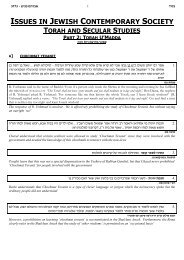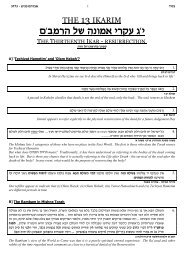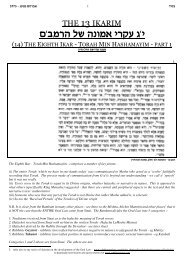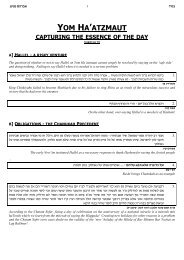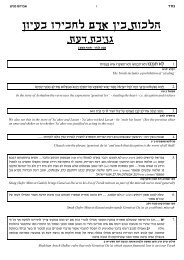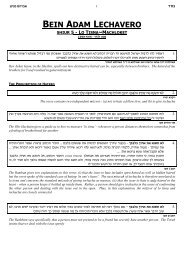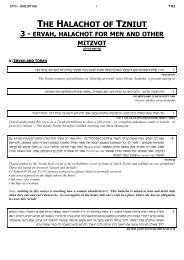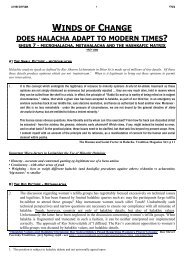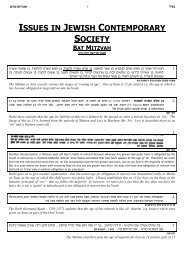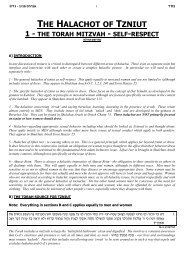Tattoos and Body Piercing - Rabbi Anthony Manning
Tattoos and Body Piercing - Rabbi Anthony Manning
Tattoos and Body Piercing - Rabbi Anthony Manning
Create successful ePaper yourself
Turn your PDF publications into a flip-book with our unique Google optimized e-Paper software.
dbhbn ovrct<br />
A] WHAT IS A TATTOO?<br />
1<br />
ISSUES IN JEWISH<br />
CONTEMPORARY SOCIETY<br />
TATTOOS AND BODY PIERCING<br />
Today, tattoos are created by injecting ink into the skin. Injection is done by a needle attached to a h<strong>and</strong>-held tool. The tool moves the<br />
needle up <strong>and</strong> down at a rate of several hundred vibrations per minute <strong>and</strong> penetrates the skin by about one millimeter.<br />
What you see when you look at a tattoo is the ink that's left in the skin after the tattooing. The ink is not in the epidermis, which is<br />
the layer of skin that we see <strong>and</strong> the skin that gets replaced constantly, but instead intermingles with cells in the dermis <strong>and</strong> shows<br />
through the epidermis. The cells of the dermis are remarkably stable so the tattoo's ink will last, with minor fading <strong>and</strong> dispersion, for<br />
an entire life!<br />
The tattoo needle inserts ink into the skin's dermal layer. Today, a tattoo machine is an electrically powered, vertically vibrating steel<br />
instrument that resembles a dentist’s drill. It is fitted with solid needles that puncture the skin at the rate of 50 to 3,000 times a<br />
minute. The sterilized needles are installed in the machine <strong>and</strong> dipped in ink, which is sucked up through the machine’s tube system.<br />
Then, powered by a foot switch much like that on a sewing machine, the tattoo machine uses an up-<strong>and</strong>-down motion to puncture the<br />
top layer of the skin <strong>and</strong> drive insoluble micrometer-sized particles of inks into the second (dermal) layer of skin, about one-eighth inch<br />
deep. (from www.howstuffworks.com/tattoo)<br />
B] THE TORAH SOURCES<br />
�v h°b£t o�f�C Ub§T¦, tO g©e�g©e ,�c«,�fU o�f§r©G�c�C Ub§T¦, tO J�p®b�k y¤r¤G±u 1.<br />
jf:yh trehu<br />
In this verse, the Torah prohibits making gashes on the body in grief for the dead <strong>and</strong>, also, as a separate prohibition,<br />
tattooing which is called ‘ketovet ka’aka’. Ketovet is writing - what is ‘ka’aka’?<br />
rcsnc) iuak :gege :okugk rhjan tuvu yjnc ugegena okugk ejnb ubhta gueau veujnv c,f (tf ,ufn) :gege ,c,fu 2.<br />
gerec ihcuj,u iheujn utmnbu ovhkg o,ut ihku,u .rtc .g ihcju, 'oubgeuvu<br />
(tf c ktuna) 'o,ut<br />
geuvu (vf<br />
oa h�ar<br />
Rashi explains that ka’aka means thrust deep into something - ie writing that is deep below the skin <strong>and</strong> is indelible.<br />
Rashi uses the wording ‘leolam’ - permanent. So that mean for life or just ‘a long time’?<br />
vsucgk onmg ohnaura ohudv dvbn vhva /// vz odu ubhbhg ihcnu ubpudn vrz vsucg hbhbg kf ,ejrvk /// vumnv haran 3.<br />
v,sucgk oarunu vk rfnb scg tuva rnukf ovka vrz<br />
d�br lubhjv rpx<br />
The Minchat Chinuch underst<strong>and</strong>s that the roots of the prohibition lie in idol worship <strong>and</strong> ‘marking’ oneself for service of<br />
another force<br />
s�xc
dbhbn ovrct<br />
2<br />
s�xc<br />
k-tv hfrsn ,uhvcu vtnuyv jur hfrsk vtucbu vrvy jur hfrsn oruxc ,ush,g ,sdvc okmt ohfrs uhv vkt kf<br />
,hrcv ,ut sckn ubracc ,ut ,,k gege ,cu,fc ifu //// uscgk ase rat ung ,upud kkjk usucfu<br />
4.<br />
uf:yh trehu ubrupx<br />
The Sforno underst<strong>and</strong>s that the roots of the prohibition lie in avoiding an impure route to service for G-d <strong>and</strong> also<br />
recognizing that the body itself is sanctified, especially by the presence of the brit milah<br />
h�f�k©n r�p¥x k�g oh�cU,�F o²B¦v (gege ,cu,f - h"ar) uh�k�g t�m§n°B©v±u (unt kg tca - h"ar)<br />
v¨G�g r¤J£t uh¨,«c�g«,±u oh¦e²hIv±h h¥r�c¦S r¤,®h±u 5.<br />
////// v¨sUvh°u k¥t¨r§G°h<br />
j:uk �c ohnhv hrcs<br />
King Yohoyakim is singled out for criticism for the the fact that he slept with his mother <strong>and</strong> he had tattoos<br />
hcr /oaur tuva rcs kfcu kujfcu uhsc gegehu cu,fha sg chhj ubht c,f tku gege gege tku c,f gege ,cu,f c,ufv 6.<br />
wv hbt ofc ub,, tk gege ,cu,fu rntba o¥av oä cu,fha sg chhj ubht rnut iugna hcr ouan vsuvh ic iugna<br />
u vban d erp ,ufn ,fxn vban<br />
The Mishna brings two opinions. The first opinion is that the Torah prohibition is only if one has writing & punctures the<br />
skin. Either one without the other is not a Torah prohibition (the Mishna does not deal with the question of <strong>Rabbi</strong>nic<br />
prohibitions). The second opinion (of R. Shimon ben Yehudah) is that the Torah prohibition of tattooing is only to tattoo<br />
‘the Name’<br />
oa cu,fha sg chhj ubht trpe rc hb,sf tk vhk rnt ?ann wv hbt cu,fhs sg hat crk tcrs vhrc tjt cr vhk rnt 7.<br />
rjt tku wv hbt wv hbt ofc ub,, tk gege ,cu, fu rntba ohcfuf ,sucg<br />
/tf ,ufn<br />
The gemara here clarifies that R. Shimon ben Yehudah’s opinion relates to tattooing the name of an avoda zara rather<br />
than the Name of Hashem. From the fact that the gemara debates his view, some commentators have suggested that the<br />
halacha follows him. The consensus of all poskim is however that the halacha is like the Tana Kama - the first opinion<br />
ihchhj ovhba urhcj ka uracc gege ,cu,f c,ufv 8.<br />
uy vfkv s erp ,ufn ,fxn t,pxu,<br />
The prohibition is two-fold - upon the person writing the tattoo <strong>and</strong> the person receiving the tattoo<br />
- i�chr)<br />
gege ,cu,ff ,htrba hbpn u,fn hcd kg vken rpt i,ha ostk uk ruxt vcvt rc tst cr rnt thfkn cr rnt 9.<br />
hchc cr ////// (tk tnkgc rpg kct inz rjt oa vtrb oaurvu vfnv ouen ,gegenu thv vaea hpk rnte teus : vken rpt<br />
:uhkg jhfun u,fn vfn oa aha ouen kf rnt hat cr /t,khxufs tschrt hpt shpe hhct rc<br />
/tf ,ufn<br />
Rav Malkiya said in the name of Rav Adda bar Ahavah: A person is forbidden to put ashes on his wound because it<br />
appears like tattooing ... Rav Bibi bar Abaye was careful even on the puncture made by a lancet. Rav Ashi said:<br />
wherever there is a wound, the wound proves it<br />
The gemara then debates whether there is a <strong>Rabbi</strong>nic prohibition of placing ashes onto a wound since it looks like a<br />
tattoo since the ashes leave a mark once the wound has healed. The first opinion (Rav Adda) says this is a problem. The<br />
second (Rav Bibi) extends the concern even to a tiny mark on the skin. Rav Ashi however states that there is no problem<br />
associated with ashes on wounds since the wound itself shows that this is not a tattoo<br />
Some questions arising out of the analysis so far include:-<br />
• does the Torah prohibition relates only to tattoo letters or also to pictures. If only letters are prohibited min haTorah is<br />
there a <strong>Rabbi</strong>nic prohibition on pictures. What about mere marks? Is that the debate between Rav Adda <strong>and</strong> Rav Bibi?<br />
• does the Torah prohibition require an order to puncturing <strong>and</strong> writing or will either order be prohibited. Again, what<br />
about derabbanan<br />
• what about merely writing on skin which will rub off. Is that totally permitted<br />
• how permanent must the tattoo be to be assur minhaTorah?
dbhbn ovrct<br />
vzu /ohnaurv ohbugcm rta ut uhs ut kujf vyhrav ouen tknhu urac kg yraha tuv vru,c vruntv gege ,cu,f<br />
sjtc ouarha ,gnu /v,sucgk oarunu vk rufn scg tuva rnukf ohcfuf ,sucgk inmg ihnaura o"ufgv dvbn vhv<br />
tku gcmc oara ut gcmc oar tku c,f /veuk vat ihc aht ihc ;udv in ouen vzhtc yuraha rjt ihnaurv ohrcsn<br />
gege ,cu,fu rntba gegehu cu,fha sg ruyp vyhrac c,f<br />
3<br />
th vfkv ch erp ohcfuf ,sucg ,ufkv o"cnr<br />
'Ketovet Ka’aka’ which is mentioned in the Torah is where one punctures the flesh <strong>and</strong> then fills the puncture mark with<br />
dye or ink or any other permanent color. And this was the custom of idol worshipers to mark themselves for idol worship<br />
as if to say they were sold to it <strong>and</strong> marked for its service. One who marks with one of the permanent markers after<br />
having punctured in any place on the body, whether man or woman will receive lashes. If he punctured [katav] but did<br />
not mark or marked with color but did not write with a puncture, he is exempt until he punctures [katav] <strong>and</strong> writes<br />
[ka’aka] - as it says ‘uketovet ka’aka’ .<br />
The Rambam rules like the mishna we saw above, although (unlike Rashi) he underst<strong>and</strong>s that ‘katav’ is the puncturing<br />
<strong>and</strong> ‘ka’aka’ is the is writing with ink. Does this imply that the Rambam underst<strong>and</strong>s that the order must be (i) puncture<br />
then (ii) write but that Rashi would require writing then puncturing, at least for the Torah prohibition?<br />
i,hk r,un :d /// ohnaurv ohbugcm rta ut uhs ut kujc vyhrav ouen tknnu urac kg yruaa ubhhv 'gege ,cu,f :t 11.<br />
ruxt tvhn vkj,fks vtrbu /ruyp 'jrch tka uscg kg oaurv :s u,fn kg vken rpt<br />
pe inhx vgs vruh lurg ijkua<br />
The Shulchan Aruch rules that it is prohibited to puncture then write in any indelible ink. He rules like Rav Ashi that<br />
ashes on a wound is permitted. Marking a slave so that they will not run away is prohibited but not min haTorah. Note<br />
that the Shulchan Aruch did not say that the tattoo must be permanent to be prohibited<br />
gcm ouenc yrua f"jtu vkj, gcmc c,uf v"vu :wuf yruaa ubhhv t 12.<br />
pe inhx vgs vruh l"a<br />
The Shach (17C commentary on Shulchan Aruch) here confirms that the order is irrelevant - marking then writing or<br />
writing then marking is prohibited. All authorities therefore agree that puncturing then writing is assur min haTorah.<br />
Most hold that reversing this order is also assur min haTorah <strong>and</strong> everyone agrees that this is at least assur<br />
miderabbanan<br />
Will writing on skin with ink but without puncturing the skin also be prohibited? The Gemara in Gittin 20a refers to the<br />
case of a Get (religious divorce) written onto the h<strong>and</strong> of a slave<br />
chhj ubht iugna wrku (/tf) ,ufns d"pc ib,sf kujfcu uhsc gegehu cu,fha sg truxht tfhk t,hhrutsn /gege ,cu,fc 13.<br />
rpt whpts tfv tfht ibcrs truxht uvhnu /trndc o,v arpnsf z"gs oa whp oav ,t cu,fha sg gegeu c,f whpt<br />
gege ,cu,ff vtrba hbpn u,fn hcd kg i,hk ruxt vken<br />
/f ihyhd ,upxu,<br />
Tosafot rules that the Torah prohibition is broken only when there is puncturing AND writing. However, he adds that<br />
there is a <strong>Rabbi</strong>nic prohibition just to write the get on the h<strong>and</strong>, which he appears to prove from the case of the ash on<br />
the wound. What kind of writing is Tosafot referring to ?<br />
The Minchat Chinuch in Mitzva 253 writes that the only prohibition will be to write with permanent ink. Thus any<br />
writing which will rub off will be permitted. Some other Acharonim do underst<strong>and</strong> Tosafot to be prohibiting temporary<br />
markings too but only if they look similar to a tattoo<br />
Applications:-<br />
• Henna tattoos <strong>and</strong> other temporary tattoos will be permitted according to most poskim but prohibited according to<br />
some<br />
• Permanent Make-up is a form of semi-permanent tattooing (also called micropigmentation or dermapigmentation). It<br />
lasts around 3 years. Most poskim consider it to be prohibited min haTorah. All agree that it is prohibited at least<br />
miderabbanan. Some poskim are lenient to allow cosmetic tattooing for ‘kavod haberiot’ - eg to repair scar damage. A<br />
she’ela must be asked<br />
• Marker Stamps on skin - is permitted according to all opinions<br />
• Writing on Skin - is permitted according to all opinions<br />
s�xc<br />
10.
dbhbn ovrct<br />
C] TATTOO REMOVAL<br />
4<br />
Tattoo removal by laser treatment is permitted. Treatment by the further injection of chemicals may be prohibited. There<br />
is no halachic obligation to have a tattoo removed. It is NOT true that a person with a tattoo cannot be buried in a<br />
jewish cemetery. THIS IS A MYTH!<br />
Some poskim have rules that a person should have a tattoo removed (in a permissible way) to avoid reminders of the past<br />
infraction of the prohibition. In the case of tattoos from the camps in the Holocaust, Rav Oshry (who lived through the<br />
Holocaust <strong>and</strong> dealt with many of the accompanying halachic issues) ruled that a survivor should wear their tattoo as a<br />
badge of pride.<br />
D] FAQS ON TATTOO<br />
1. Q Are they only prohibited if done for idol worship?<br />
A No - they are prohibited even for aesthetic purposes<br />
2. Q What if they are semi-permanent?<br />
A They are still prohibited min haTorah according to most poskim<br />
3. Q Can I get one done by a non-Jew?<br />
A No - the prohibition is the same<br />
4. Q What about tattoos which are pictures <strong>and</strong> not writing?<br />
A Most poskim consider these to be prohibited min haTorah. All agreed that they are prohibited.<br />
Even to make a permanent mark on the body is prohibited<br />
5. Q What about fake tattoos eg henna tattoos<br />
A Most poskim allow these since are not injected <strong>and</strong> they wash off quickly. Some are strict in<br />
the a case of fake tattoos which look like real tattoos<br />
6. Q Can I write on my skin in pen<br />
A Yes<br />
7. Q Can a Jew with a tattoo be buried in a Jewish cemetery<br />
A Yes<br />
8. Q Is permanent make-up allowed?<br />
A No. Most poskim consider this to be assur min haTorah. All agree that it is prohibited<br />
9. Q What about cosmetic tattooing for treatment of distressing medical skin conditions<br />
A Some cases may be permitted - a she’elah must be asked<br />
10. Q Should I have a tattoo removed<br />
A It is not required. Some poskim recommend it<br />
E] BODY PIERCING<br />
(i) Bal Teshaktzu<br />
<strong>Body</strong> piercing for aesthetic reasons (eg ear piecing) is not prohibited. How far does this go?<br />
o�C o¤,¥n§y°b±u o¤v�C Ut§N©Y¦, tO±u .¥r«�©v .¤r¤�©v k�f�C o�fh¥,«J�p³b ,¤t Um§E©J§T k©t 14.<br />
dn:th trehu<br />
One of the mitzvot is ‘bal teshaktzu’ - not to do anything disgusting. This begs the question of who defines <strong>and</strong> how<br />
objectively we can define what is ‘disgusting’<br />
s�xc
dbhbn ovrct<br />
(ii) Chukat Hagoy<br />
5<br />
tO o¤vh¥,«Eªj�cU UG�g©, tO v¨N¨J o�f§,¤t th�c¥n h°b£t r¤J£t i�g³b�F .¤r¤t v¥G�g©n�fU UG�g©, tO V�C o¤T�c©J±h r¤J£t o°h©r�m¦n .¤r¤t v¥G�g©n�F 15.<br />
:Uf�k¥,<br />
d:jh trehu<br />
There is also a prohibition of ‘chukat hagoy’ - following the customs <strong>and</strong> practices of the non-Jewish world. This also<br />
raises the issue of what falls into the category of chukat hagoy<br />
'ohudv<br />
,uejc ufk, tku rntba ivc tmuhfu rgac tku aucknc tk ivk ihnsn tku ohcfuf hscugv ,uejc ihfkuv iht 16.<br />
ugsnc ivn kscun tuva unf uhagn rtacu uaucknc gushu ivn kscun ktrahv vhvh tkt //// 'ufk,<br />
tk ovh,uejcu rntbu<br />
'oatr ,hmhm unf uatr ,hmhm ksdh tku 'ivk sjuhnv aucknc ackh tk 'ohngv in of,t khsctu rnut tuv ifu 'uh,ugscu<br />
jhbhu iztk iztn uhbp sdbfn rgav jkdh tku ',hrukc trebv vzu ihaug iva unf gmntc rgav jhbhu ihssmv in jkdh tku<br />
///// iv ihauga lrsf uhrjtkn grpv<br />
t vfkv th erp ohcfuf ,sucg ,ufkv o"cnr<br />
It is clear from the Rambam’s definition that this mitzva applies particularly to adopting certain styles of hair <strong>and</strong> dress<br />
(iii) Beged Isha<br />
For men there will also be a Torah prohibition of doing anything which is ‘effeminate’. This is also a subjective <strong>and</strong><br />
changing definition<br />
(iv) Tzniut<br />
(v) Respect for the Human body <strong>and</strong> concept of Tzelem Elokim<br />
(vi) Mikva issues - chatzitza<br />
(vii) Health issues<br />
s�xc



